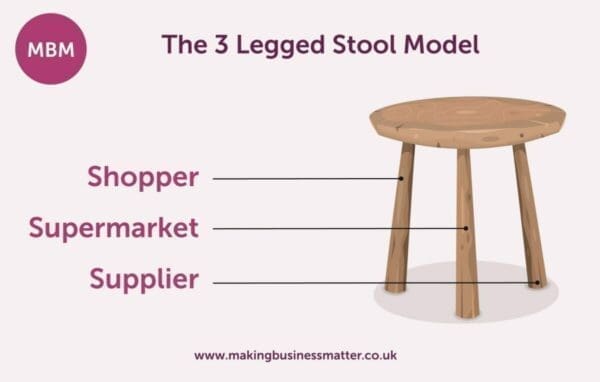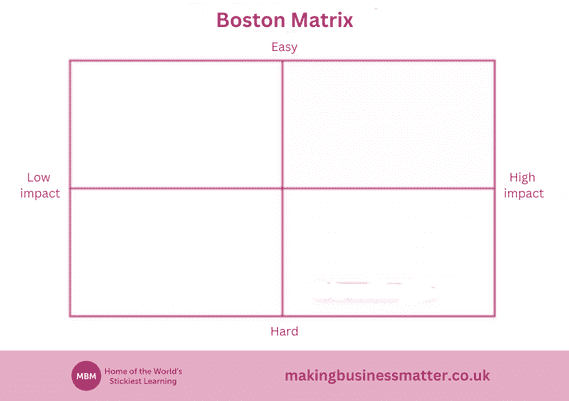Discover How to Build a Category Strategy Plan in 4 Steps
Category planning and category strategising can be a topic surrounded by confusing terms like ‘demand management’ and ‘range optimisation.’ Luckily, this article will show you how to build a category strategy plan in 4 steps.
Let’s keep it simple and practical…
Overview of the Category Strategy Plan Process
It is possible to start your thinking very wide, like a supermarket chain and then consider which categories are a destination, seasonal, the competitive set of the supermarket, and build an eye-watering 5-year plan that will win awards.
Well, this is not that. In fact, I am going to make these assumptions:
- You’d like something simple.
- A practical plan is what you need.
- Building a category plan that galvanises the team towards one North star, is what you want.
- Choices you can make about whether to go left or right.
- An understanding of the 4 components that make a category strategy.
- Ultimately, you’d like a category plan that could fit on one page (A S.O.A.P – Summary on a Page).
- You want a template that you can take away and fill in yourself.
- There is a group of products you have identified that you call a category and that category needs a category strategy.
- You’re prepared to put a good amount of time into building this because you understand the benefits.
- Probably, you have been disillusioned by complex plans that are great but have sat on a shelf gathering dust.
If you agree with my assumptions above, crack on reading, please. If you want something much more highfalutin, this is not it. You’d be better off calling in one of the big agencies, spending 6 figures and probably having a category plan that will take 6 months to build and by the time you did it, it is out of date.
Jump to Building Your Category Plan:
#1: Category Target in Detail
#2: Category Strategies in Detail
#3: Category Tactics in Detail
#4: Category Dashboard in Detail
The 4 Parts of the Simple and Practical Category Strategy Plan

Part #1: Category Target
This is the ‘North star’. The thing that anyone who has an impact on the performance of the category looks toward. It is the equivalent of Suzuki’s mission statement in the 1980’s – ‘Kill Yamaha.’ It galvanises the team towards one end, enabling them to use it as a yardstick against the efforts they make. For example:
Is what I am doing on this category going to make a difference to the category target (the North star)?
Part #2: Category Strategies
These are the big projects/the big pieces of work that make the difference in whether we reach the category target, or not. These must be chosen carefully because the risk is choosing too many, splitting the efforts of the team too wide, and risk achieving very little. And/or, choosing a bunch of strategies and then trying to make it look less by bundling a bunch together. Remember rifle, not a shotgun.

Every category could do with improving its range, availability, merchandising, packaging, marketing, pricing, and many other things. Selecting which ones are the key to success.
Part #3: Category Tactics
As the category plan moves down the page/template, the level of granularity increases. From the big category target at the top of the page/template setting the way forward, to the strategies showing us how, to the tactics explaining exactly how.
Each category strategy is broken down into 3 smaller projects (tactics) so that we can assign accountability and understand the progress of each tactic. In turn, each strategy, and then category performance against the category target.
Part #4: Category Dashboard
As it says, a dashboard. Like that in your car. Providing the information you need to know whether everything is as it should be. The only difference is that this dashboard shows the performance vs the category target, the progress of the strategies, and whether the tactics are being delivered. This is how you keep your finger on the pulse of progress.
📥 Get My Free Category Strategy Template Below:
>> PDF Template <<
>> Editable PowerPoint Template <<
Building Your Category Plan with these 4 Components
Part #1: Category Target in Detail

This is the toughest choice to make. An effective category strategy is about making the right choices. Any fool can create a plan that tries to do everything but building a plan that makes a significant difference to the category by choosing to focus, that’s more difficult.
There are 3 different types of category targets that you can choose from:
- Shopper Target
- Supermarket Target
- Supplier Target
Shopper Target
A shopper target can only choose to do one of 3 things, and not more than one.

In simple terms, a category shopper target should only choose one of the above 3 targets; Get shoppers to buy more each visit – Weight Of Purchase (WOP), Get shoppers to buy more often – Frequency Of Purchase (FOP), or Get more shoppers to buy from the category – Penetration (PEN).
Your aim is to change their behaviours – the buying patterns of your category shoppers and you want them to do something different, for example, buy more often.
Warning: You cannot choose more than one of the 3 shopper targets because A. You are not making a choice, B. The team will be confused by having two North stars to fo follow, and C. If you choose, for example, to increase penetration, then the frequency will decrease because new shoppers to a category will always buy new things less often than established shoppers.
Selecting the Right Shopper Target
There are an infinite number of ways of choosing the right shopper target. Begin by understanding the size of the prize for each of the WOPFOPPEN to achieve a fair share. Our fair share tool will help to calculate this.
Alternatively, McDonald’s encourages their franchisees to know their best hour, best shift best day, best week, best month and best year. This is because they have achieved it before and so it sets a benchmark of what is possible. They call these the ‘Golden…’; Golden shift, Golden hour, etc.
For example, what is the highest frequency your category ever achieved? Maybe that is the category target. The next step is to know whether it is an eye-watering big number and whether the target would unite the team to say, ‘Yes, let’s go get that!’ If they do say Yes, then maybe it is the answer. After all, no one wants to chase £11.20!
Make the Shopper Target Simple
Big numbers are great to chase, but we also need to be practical and ground ourselves. So, next, turn the big number (category target) into a practical piece that everyone can understand and come away thinking, ‘Yep, we can absolutely do that.’ For example, the £112m category target to increase frequency is ‘just’ about:
Getting our current category shoppers to buy just once more per year.
A simple, and practical category target encourages everyone to take a fresh look at what they are doing and challenges them to ask themselves whether that action will make a difference to that target. If it doesn’t stop doing it. If it does, do more of it.
For example, if we do a 3 for 2 promotion how much will it make an impact on achieving our target of increasing frequency by one this year? Or, range reviews take a long time – how can we bend the range review efforts to ensure that we make an impact on the shopper target of category frequency?
Is Your Shopper Target SMART?
In my experience of discussing and identifying category targets, they all understand SMART and can recite what it means, yet few apply it. They give up after applying 3 of the letters and fudge the rest.
A category target must be SMART. It must be able to put a tick against each and every one of the 5 letters. Not 3, or 4, but 5, because to miss one is, to begin with, an ambiguity that will grow and become more magnified as you add granularity to your plan.
Only when you are discussing the implementation of a tactic will you find out the fog in your category target. Not adhering to SMART means that the tactic causes debate that can not be resolved because the tough choices were not made at the start. The choices were fudged and so the ‘fudging’ grows throughout the plan.
Click the image below for a larger resolution.

A poor shopper target would be:
Increase penetration in 2023.
Supermarket Target
The shopper target is king because, after all, that is why we are here, to meet the needs of our shoppers better and quicker than our competition and by doing so we make more money. It’s that simple and that hard.
There are many definitions of Category Management. They’re well written, thought through and comprehensive. Yet, we believe that Category Management is about:
Disappointing the fewest amount of shoppers by optimising the 3-legged stool.

As Stephen Covey, the author of The 7 Habits of Highly Effective People, called it in Habit #4: Win-Win. There is no point in just one party winning because eventually, they’ll all fail if they do.
For example, the supermarket can win by taking all the profit but ultimately they will have no suppliers to supply the products to their shoppers. The same goes for any party. It needs to be a 3-legged stool, otherwise, it is wonky.
When it comes to category targets I recommend having a shopper target. This leads the plan. It is the tip of the sword. You may then calculate from this that, for example, increasing the frequency by one, calculates as the supermarket achieving 21% market share, and also that the supplier’s sales grow by +13%.
The latter two are calculations from having decided the former. You do not want 3 targets, one for the shopper, supermarket and supplier, that all pull against each other. They must be aligned. Begin with the shopper.
Supplier Target
Often the forgotten part of the category plan is the supplier target, as most category strategies lead with shoppers or supermarkets. But the 3-legged stool principle allows for all three parties to be considered.
You don’t have to have a category target beyond just a shopper one. Personally, I like the simplicity of one target because I have seen sales teams that have a target, a stretch target and the big target. It just causes confusion and drains motivation.
Be bold, have one target and ensure everyone that works on the plan knows it, understands it, and could explain their role in delivering it. If you achieve the singular category target (shopper target) early, you can always celebrate and use that winning platform to set a higher one.
Part #2: Category Strategies in Detail

If the category target is the what, then the strategies are the how. Category Target – What do we want to achieve? Category Strategies – And then how will we achieve it?
Again, making choices is the toughest part here. There are a thousand big things that you could do to improve category performance, and you are probably trying many. The challenge is that you are doing too many, without focusing on a few. Back to our rifle versus shotgun analogy.
Pareto, the Italian philosopher identified the 80:20 rule. For example, 20% of the tasks on your to-do list will make 80% of the difference. Or 80% of the cars on the road are 20% of all the available models. His principle can be applied everywhere. We need to choose. To do this I suggest a category strategy planning session – Read on…
Category Strategy Brainstorming
1. Gather the team together:
The team should be those that know the category and have a vested interest in improving its performance. Plus, we always like to include a ‘naive resource’ – Someone that is not too close to the category and may just ask the killer question or have the killer idea. Like the guy who made the post-it note. 3M were creating a superglue, and it failed. He saw success as failure.
2. Tools:
You’ll need a flipchart pad, marker pens and post-its.
3. Do this in 2 hours:
Brief the team as to why they are there, agree on the ground rules, and that you’ll need 2 hours.
4. Team input:
Give some input to the team about the category without bringing them into your pit (A term for explaining a problem and then everyone sees the same problem because they are in the pit with you). You are sharing an objective look at the category and bringing it to life with products, images, and not a PowerPoint deck of boredom. Take a maximum of 30 minutes and encourage questions, remember not to answer by bringing them into your pit.
5. Strategies vs. tactics:
Explain the difference between strategies and tactics with one being big projects and the other being the actions to get those done.
Next, ask the team to write the big things (strategies) that they believe will make a significant impact on the category. One per post-it note. Plus, they must be specific, ‘promotions’ on a post-it note is not enough because anyone could write that.
We want their knowledge and experience of the category to suggest things like, ‘Change all packaging to bags’ or ‘ Remove the top tier.’
6. Facilitation:
As the facilitator, push and challenge them a few times, offering snippets of input. See our brainstorming article to help.
7. Make your Boston matrix:
Once all the post-it notes have been written, thank the team and now show them the large Boston matrix on the wall of 4 flipcharts. Explaining the horizontal axis (x) is the impact on the agreed category target. On the right is high impact and on the left is low impact. The y-axis is about ease. At the top is easy and at the bottom is hard.

8. Use your instincts:
Ask the team to place their post-it notes on the matrix above and encourage them to go with their instincts. Little debate and more gut feeling. Warning: I have seen teams get stuck on one issue and use this forum as the time to resolve long-held beliefs. This is not that forum.
9. Make the choice:
Then, the group is to look at the top right box; easy to do and high impact. They then must choose between 3 and 7 strategies that will become the category plan strategies.
10. Take caution:
Be careful that the team doesn’t try to bundle several strategies into one. The strategies need to be specific & measurable, and hard choices need to be made.
Cat Strat Post Brainstorming
You now have 3-7 category strategies. The minimum is 3 because any less and there is not enough to make the impact and 7 is a good number because the brain can handle up to 7 things well.
Assign an owner for each strategy. Plus, agree on a measure for each strategy. Remember that measures and targets are different. For example, if the category strategy is to increase frequency by one, then a strategy might be to change the promotional programme. The measure of the promotional programme is frequency.
Let’s say it currently achieves a frequency across all promotions of 5 per year and it now needs to achieve 6 per year. The measure is shopper frequency on promotions and the target is to achieve 6 times per year. A brief description of what the strategy is aiming to achieve will help.
Part #3: Category Tactics in Detail

When the category target is discussed, they are the what and the strategies are the how. When we discuss strategies, they are the what and the tactics are the how. Tactics are simply a further level of granularity. Basically, tactics are – how will the strategies be achieved?
The tactics are not achieved by a brainstorming session but by the category strategy owner. The owner writes and then presents back to the group up to 3 tactics of how the category strategy will be achieved.
For example, if we take our frequency category target and our promotions category strategy we discussed above, we might see:
- Category Target: Increase frequency from 5 in 2023 to 6 in 2024.
- Category Strategy #1: Increase promotional frequency from 6 in 2023 to 7 in 2024.
- Category Tactic #1.1: Analyse each of our promotions to understand the frequency.
- Category Tactic #1.2: Analyse two competitors to understand their promotional frequency.
- Category Tactic #1.3: Recommend Q3 of 2023 promotions using the insights from tactics 1 and 2 above.
Category Tactics as Milestones
Brian Tracy talks about ‘one barrel at a time‘. He shares his story with us…
The French, who had controlled Algeria for many years, had marked a path across the desert with black 55-gallon oil drums. The drums were spaced exactly five kilometres apart. As we drove and came to an oil drum, the next drum, which was five kilometres ahead, would pop up on the horizon, and the last oil drum, which was five kilometres behind, would fall off the horizon as if shot in a shooting gallery.
Wherever we were, we could always see two oil drums at a time — the one we had just left, and the one we were headed toward. To cross one of the greatest deserts in the world, all we had to do was to take it one oil barrel at a time.
We did not have to cross the entire desert at once. We had to cross it only one oil barrel at a time, and that would be sufficient.
Tactics need to be written as completed actions. As though the barrel had been reached.
Example: Promotional programme analysed for two competitors.
Tactics are written as outputs, not inputs. As though they have been done. These are your milestones and your barrels. Then, we take each milestone and put it on an excel file with dates across the top.
The excel file becomes our desert and the tactics our barrels. We then have a map of how we will achieve our category target, one barrel at a time, ticking off each tactic, which in turn delivers their strategies and in turn delivers the category target.
The one barrel-at-a-time approach also helps us to manage our expectations. Sometimes it can be overwhelming to see the category target because it is just too big and too far away. Yet, one tactic at a time is very possible.
Part #4: Category Dashboard in Detail

The experience of most people is that category strategy plans are built with love and sit on a shelf with hate. Their experiences have taught them that category planning is a huge affair, taking a long time, a lot of effort and yielding little. Yet, performance improvement happens in the doing, not the creating. Our guiding principle is:
Ready, aim, fire.
Yes, your category targets need to be SMART, and your strategies are well chosen, but overthinking and wanting to find every piece of data to support your decision will result in very little achievement. Trust your instincts, make decisions, learn and keep moving forward by monitoring performance with the dashboard.
A dashboard needs to achieve 3 things:
- Easily understood.
- Easily updated.
- Easily learnt from.
KISS Category Dashboard
I have seen elaborate dashboards built with advanced excel formulas that ‘only had to be updated once,’ said the excel whizz, and then he left and everyone was scuppered. My 7 tops tips so that you do not fall foul of work that never gets used is:
- Start small.
- K.I.S.S.

- Build it slowly.
- Make it live and breathe (You’ll need to give it the kiss of life in the early days because new things are largely welcomed and then ignored).
- Don’t be too fancy with the tech – a simple email body will do to start with because remember opening an attachment is another click. Sometimes a click is too far.
- Use Red, Amber and Green, to highlight the good and bad.
- Share 1 learning in each dashboard. For example, Strategy 2, Tactic 1: Analysing the competition’s promotional frequency will be late because we had to wait for the Kantar data. Delayed 2 weeks. Desert (excel plan) adjusted.
Include performance versus the target, performance versus each strategy target, and commentary on the milestone map.
A Metaphor that Works with Our Learners
In our Category Management training course, our Learners like the metaphor we use for category planning.
The rock, the stones, the pebbles and the sand.
The category target is the rock. The unmoveable big rock that everything works toward – the category target. Then, they are the stones, which are the strategies supporting the rock. The pebbles are the tactics supporting the strategies and everything else is the sand. Sand is the millions of actions that need to support the rest. The sand is the foundation because it is where all things happen. The key to success is ensuring that the sand (daily actions) work towards, ultimately, supporting the rock.
Good luck! Most of all, remember to celebrate the wins along the way.
For more useful content like this, make sure to join our newsletter.



